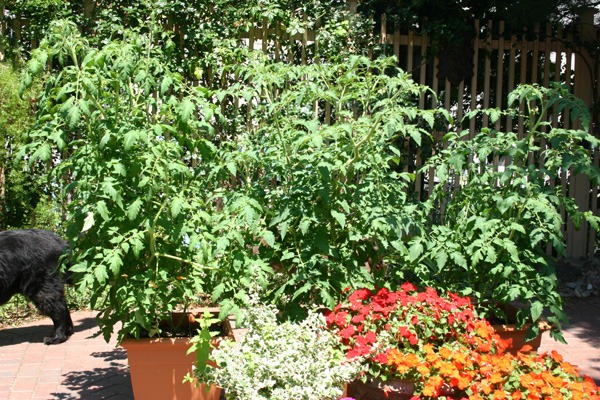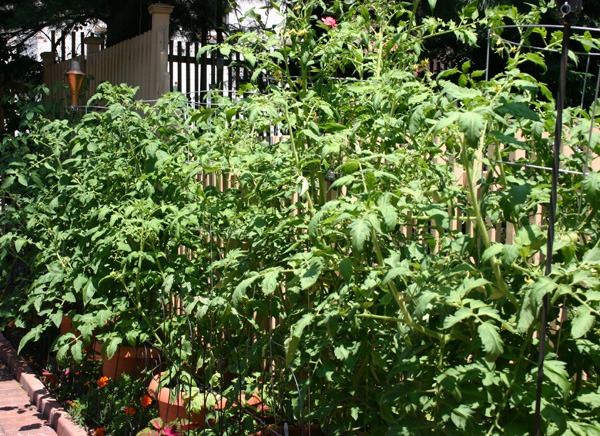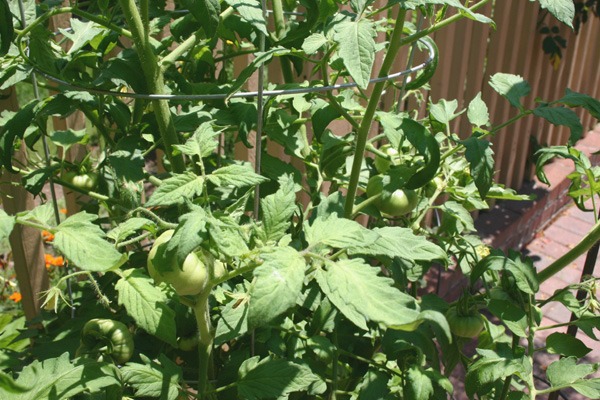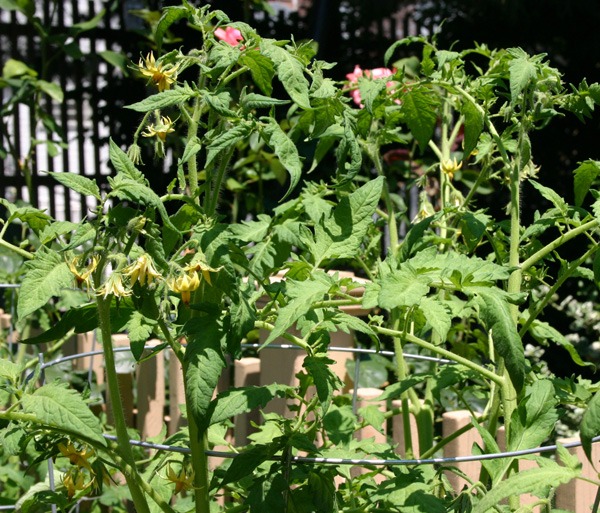 The rule-of-thumb is that tomato plants double in size every ten to fourteen days. With the sun, torrential rains and warm evenings we’ve had here in Brooklyn, plus my magic elixir of Miracle Gro, epson salts and fish emulsion, these plants made the mark.
The rule-of-thumb is that tomato plants double in size every ten to fourteen days. With the sun, torrential rains and warm evenings we’ve had here in Brooklyn, plus my magic elixir of Miracle Gro, epson salts and fish emulsion, these plants made the mark.
 This year, I’m growing mostly heirloom varieties with bizarre names like “Mortgage Lifter” and “Black Zebra”. The grower I got them through wrote some appetizing prose about each variety but kinda missed on the specifics. For instance, I didn’t know if I was planting any cherry tomatoes until the first fruit appeared and I deduced that “Sugar Nugget” must be a cherry tomato. Just in case, I planted a Sweet 100 cherry from the local nursery too.
This year, I’m growing mostly heirloom varieties with bizarre names like “Mortgage Lifter” and “Black Zebra”. The grower I got them through wrote some appetizing prose about each variety but kinda missed on the specifics. For instance, I didn’t know if I was planting any cherry tomatoes until the first fruit appeared and I deduced that “Sugar Nugget” must be a cherry tomato. Just in case, I planted a Sweet 100 cherry from the local nursery too.
 This is one of those “Mortgage Lifters”. From the story, this hybrid was developed in the 1930s by a radiator repairman. His plant was such a success with tomato fanciers that he paid off his mortgage selling seedlings — hence the name. When ripe, the tomato is two to four pounds and looks something like a small, red pumpkin.
This is one of those “Mortgage Lifters”. From the story, this hybrid was developed in the 1930s by a radiator repairman. His plant was such a success with tomato fanciers that he paid off his mortgage selling seedlings — hence the name. When ripe, the tomato is two to four pounds and looks something like a small, red pumpkin.
The Mortgage Lifter doesn’t only produce large tomatoes. It’s also very prolific. Check out all the flowers here. Two weeks from now I could have sixty or seventy pounds of tomatoes hanging on this one vine so I need to figure out a way to support the branches better.
 Here’s an example of the pruning I posted about earlier. Once the flowers start to form, it’s time to get rid of the suckers and low-hanging foliage below the lowest flowering branch. In a few days, I’ll remove a bit more. This helps persuade the plant to stop making foliage and start pushing energy to the fruit.
Here’s an example of the pruning I posted about earlier. Once the flowers start to form, it’s time to get rid of the suckers and low-hanging foliage below the lowest flowering branch. In a few days, I’ll remove a bit more. This helps persuade the plant to stop making foliage and start pushing energy to the fruit.
One of the Italian growers around here told me that a healthy, productive tomato plant actually looks a bit scraggly. You don’t want any foliage that saps energy from the fruit or which prevents air from circulating and increases the chance of disease.
![]()

